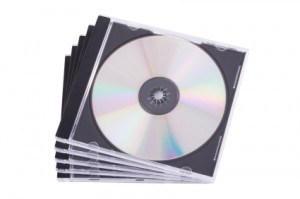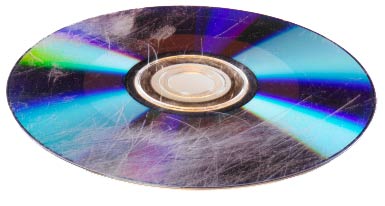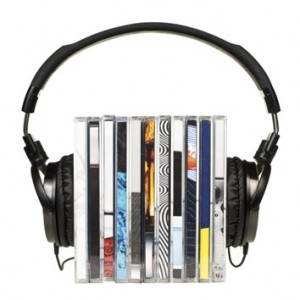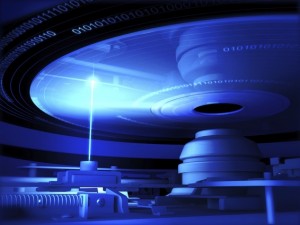
It can be tricky to find the right CD
Since the development of the simple Compact Disc, so many other formats have become available it can be very confusing to know which ones are the best to use! Hopefully, this little guide will go some way in helping you make your mind up which one is most suited to your needs!
When considering which CD to choose, there are several factors to take into account, for instance the lifespan of the disc, which CD readers can use it, whether it will work with your recorder, the memory size and whether or not it is best suited to the job you need it to do.
The main types of CD in use are: CD, CD-R, CD-RW, DVD, DVD-R, DVD-RW and DVD-RAM. It is worth bearing in mind that each disc will have certain unviewable information already written onto it which will tell computers and CD players what kind of disc it is. Unfortunately, this unseen data cannot be changed.
Here is a guide to the main types of CD, the pros and cons to each, and the jobs they are most suited to:
A General Note on CDs: Due to their limited memory, it is advised not to use CDs for games or video, as these take up a great amount of room and are very complex files to store on such a small device. You would be better off using DVDs in this instance.
CD (Also known as CD-DA or CD-ROM)
Lifespan: 50-200 years
Memory: Up to 700 Mb (80 minutes)
Recording Speed: N/A
Cost: More expensive than the home CD duplication, but you pay for a professional looking product. If you want more than 500 copies of a disc it is cheaper than CD-R/-RW. Cost varies significantly depending on the company being used. I recommend Duplication Centre UK.
Players which can read it: All
Players which can record onto it: Only professional machines can do this kind of CD duplication.
Re-Record? No.
Functions: Professionally pressed CD’s which contain music files to be played on computers or CD Audio Players. Best used for band disks, promotional music, audio-information (for instance recorded speeches or radio play samples). Due to having a long life span they are very good for professional release as well. Because they are made using a Glass Master and pressing machines, you will need a replication company such as Replication Centre UK to produce them for you!
Quality Notes: Quality is guaranteed if a professional company is used. These are very difficult to create without the correct machinery for CD duplication.
Other notes: —
CD-R
Lifespan: 50-100 years if stored in a cool, dark place.
Memory: Typically 700Mb (80 minutes)
Recording Speed: Fast. The fastest out of all of the discs suitable for home CD Duplication, they can be burned in under two minutes each.
Cheaper than CD-ROMs if you want under 500 copies. You can get professional companies to produce them for you, and I recommend Duplication Centre UK.
Players which can read it: Most. Some in-car players will not play them and also some of the older CD Audio Players.
Players which can burn it: All players with CD-R or CD-RW duplicators can record them.
Re-Record? No.
Functions: These discs are generally used to store music, not because they can’t store other data – they can: Photos, small video clips, word documents, etc. – but because information is permanently placed on them, they tend not to be used for backing up files or anything else which needs only short-term storage. However, their life expectancy is not as long and they are more susceptible to damage from heat and sunshine exposure. However they are faster to produce than CD-ROMs, which need a Glass Master copy of the CD which takes time to produce.
Quality Notes: Quality varies greatly depending on the company who produced the blank CD-Rs in the first instance. It is generally recommended to go with a recognised brand who will be forced by law to stick to the standard guidelines for quality.
CD-RW
Lifespan: 20-100 years
Memory: Typically 700 Mb (80 minutes)
Recording Speed: Medium. They are not as fast as CD-Rs but not as slow as DVDs at between 3-4 minutes per disk.
Players which can read it: Mainly only computers and some CD Audio Players. However compatibility with Audio Players does go up if the CD is recorded all at once rather than in lots of segments.
Players which can burn it: Only drives with the CD-RW recording capacity.
Re-Record? Yes. Up to 1000 times.
Functions: These disks, though slightly more expensive than the CD-R, can be re-recorded onto which is a great plus. They are generally used for storage of data files such as photos, short films, word, excel or powerpoint documents, music which is still being edited, etc. They are also generally used for backing up files as, when the back up needs to happen again, you can record the information over the top of the old back up on the same disc! They can also perform the same uses as CD-Rs but are often not used for these because of the price difference and CD-RW’s incompatibility with most Audio Players.
Quality Notes: Quality varies greatly depending on the company who produced the blank CD-RWs in the first instance. It is generally recommended to go with a recognised brand who will be forced by law to stick to the standard guidelines for quality.
Other Notes: Environmentally, they are more sound than the CD-R because there is less waste – any old disks can simply be re-recorded whereas with CD-R they must be thrown out!

A general note on DVDs: It is advised, due to their cost, that DVD’s be used almost exclusively for films or games. Unless you wish to transport very large files, it is much more economical to use CDs.
DVD (Also known as DVD-ROM)
Lifespan: 30-100 years
Memory: Up to 4.7 Gb. Typically can hold up to 2 hours of video on standard SP (short play) setting
Recording Speed: N/A
Cost: More expensive than home DVD Duplication but, again, you pay for a professional finish and quality. Also the price will vary depending on which company you use. I would recommend Replication Centre UK.
Players which can read it: All DVD Players. (If you are copying a game, only certain gaming equipment will be able to use that file, depending on how you have developed the game.)
Players which can burn it: They are nearly always professionally produced due to the machinery required to create them.
Re-Record? No.
Functions: DVDs are primarily used for storing film or gaming data. It is not advised to use them for storing non-professional data as home DVD-RW duplication is much more economical in this case. However, they can be used for advertising films, full length films and games of every sort (for computer, xbox, PS3, etc.). They are also used for any film/game which needs to be distributed amongst a large audience as they do not have the drawbacks or DVD+/-R with wheather or not equipment can read them. Many things which are put onto DVD-ROMs are ordered in bulk, as it saves time to get someone else to do the job for you!
Quality Notes: Because it is professionally done, the quality is guaranteed.
Other Notes: —
DVD-R and DVD+R
Lifespan: 30-100 years
Memory: 4.7 Gb. Typically can hold up to 2 hours of video on standard SP (short play) setting
Recording Speed: Slow. Definitely slower than any CD: At between 3-10 minutes depending on the speed of you drive, DVD-/+R duplication is time consuming.
Cost: A little more than a CD.
Players which can read it: This is a little complicated: DVD-R and DVD+R while being essentially the same thing can only be read by equipment which supports them respectively: DVD-R can only be used with equipment which supports DVD-R disks and DVD+R with equipment that supports DVD+R disks. Nearly all players nowadays are DVD-R compatible.
Players which can burn it: DVD-R can only be used with equipment which supports DVD-R disks and DVD+R with equipment that supports DVD+R disks.
Re-Record? Not for DVD-R but DVD+R things can be added later as it is still accessible. This does NOT make it re-writable as data cannot be deleted from it.
Functions: These are generally used for home-videos, prototype game designs,adverts, films still in the editing stage – basically files which are enormous, complex and doesn’t need to look entirely professional. Also, these disks don’t tend to be used for things which must be produced in bulk as it would be a time consuming DVD duplication process.
Quality Notes: Quality varies greatly depending on the company who produced the blank DVDs in the first instance. It is generally recommended to go with a recognised brand who will be forced by law to stick to the standard guidelines for quality.
Other Notes: —
DVD-RW and DVD+RW
Lifespan: Up to 30 years. Less all other discs except DVD-RAM.
Memory: 4.7 Gb. Typically can hold up to 2 hours of video on standard SP (short play) setting.
Recording Speed: Slow. Definitely slower than any CD at between 3-10 minutes depending on the speed of you drive, DVD-RAM duplication is time consuming.
Cost: A little more than a CD.
Players which can read it: The same rules apply as with DVD+/-R: DVD-RW can only be used with equipment which supports DVD-RW disks and DVD+RW with equipment that supports DVD+RW disks.
Players which can burn it: DVD-RW can only be used with equipment which supports DVD-RW disks and DVD+RW with equipment that supports DVD+RW disks.
Re-Record? Yes.
Functions: These are generally used for films or games which are still in the editing process or other large files which need editing, saving or backing up. They can be used to back up much larger systems than CD’s. Not used so much for long-term storage due to their shorter life span.
Quality Notes: Quality varies greatly depending on the company who produced the blank DVD+/-RWs in the first instance. It is generally recommended to go with a recognised brand who will be forced by law to stick to the standard guidelines for quality.
Other Notes: Environmentally, they are more sound than the DVD-R because there is less waste – any old disks can simply be re-recorded whereas with DVD+/-RW they must be thrown out!
DVD-RAM
Lifespan: Up to 30 years.
Memory: 4.7 Gb. Typically can hold up to 2 hours of video on standard SP (short play) setting.
Recording Speed: Slow. Definitely slower than any CD at between 3-10 minutes depending on the speed of you drive, DVD-RAM duplication is time consuming.
Cost: A little more than a CD at between 25-30p per disk.
Players which can read it: Most DVD Players and DVD drives in computers.
Players which can burn it: All DVD recording devices will be able to burn DVD-RAM disks as they are the oldest and easiest of the disks to use.
Re-Record? Yes – up to a whopping 100,000 times!
Functions: These are generally used for films or games which are still in the editing process or other large files which need editing, saving or backing up. They can be used to back up much larger systems than CD’s. Not used so much for long-term storage due to their shorter life span. Due to the massive amount of times they can be re-written they are almost certainly useable for re-writing for their entire life-span!
Quality Notes: Quality varies greatly depending on the company who produced the blank DVD-RAMs in the first instance. It is generally recommended to go with a recognised brand who will be forced by law to stick to the standard guidelines for quality.
Other Notes: —
I hope this helps you make your mind up on which type of CD best suits your needs!



 But there are arguments for and against CD re-mastering. Why? If a process makes an old song sound better and gives it a second chance to live, what can be the problem? Well, it depends on how well the audio has been remastered: Many classic albums from bands such as Kiss and the Beatles are now being re-released in digitally remastered form, but to modern tastes and standards. This often includes increasing the volume of a song to levels where the sound becomes distorted and starts to sound very different. this can dissuade people from listening to the music again, often without them even knowing quite why. Aside from this, many people see it simply as a marketing ploy, a way for shareholders in music labels and members of the bands to get even more money than they did the first time the song was a hit.
But there are arguments for and against CD re-mastering. Why? If a process makes an old song sound better and gives it a second chance to live, what can be the problem? Well, it depends on how well the audio has been remastered: Many classic albums from bands such as Kiss and the Beatles are now being re-released in digitally remastered form, but to modern tastes and standards. This often includes increasing the volume of a song to levels where the sound becomes distorted and starts to sound very different. this can dissuade people from listening to the music again, often without them even knowing quite why. Aside from this, many people see it simply as a marketing ploy, a way for shareholders in music labels and members of the bands to get even more money than they did the first time the song was a hit.
